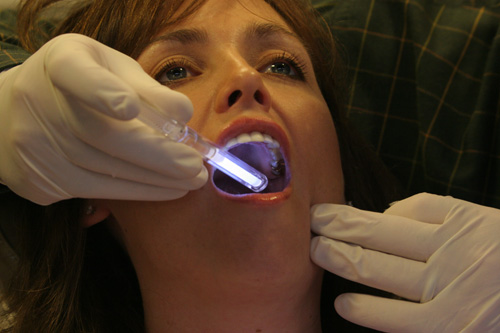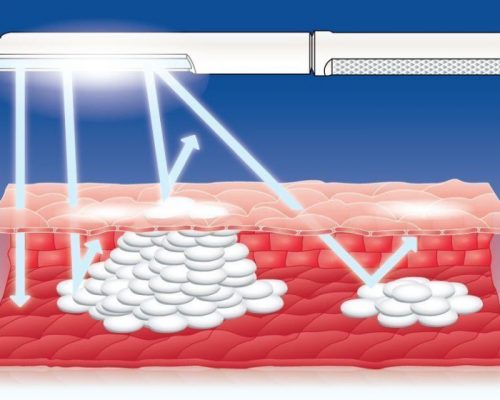Oral Cancer Exam
More common than ovarian, cervical, stomach and brain cancer; oral cancer kills one person every hour of every day in America.
The five most common sites for oral cancer are the tongue (25%), the lips & cheeks (22%), the gums (14%),
the roof of the mouth (10%) and the floor of the mouth (8%).
Are You At Risk?
Virtually everyone is at risk for oral cancer, including you. 25% of oral cancers occur in people with no risk factors. Here are the most common ones:
Gender: Oral cancer is twice as common in men as in women. This difference may be related to the use of alcohol and tobacco, which is a major oral cancer risk factor seen more commonly in men than in women.
Age: The average age at diagnosis for oral cancer is 62, and two-thirds of individuals with this disease are over age 55, although it occurs in younger people, as well.
Tobacco Use: Most people with mouth and throat cancers use tobacco, and the risk of developing these cancers is related to how much and how long they smoked or chewed.
Oral tobacco products (snuff, dip, spit, chew, or dissolvable tobacco) are linked with cancers of the cheek, gums and lips. These products also accelerate gum disease, the destruction of the bone that supports the teeth, and tooth loss.
Drinking Alcohol: Drinking alcohol increases the risk of developing mouth and throat cancers. About 7 out of 10 patients with oral cancer are heavy drinkers.
The risk of these cancers is even higher in people who both smoke and drink alcohol. According to some studies, the risk of these cancers in heavy drinkers and smokers may be as much as 100 times higher than the risk in people who don’t smoke or drink.
Sexual Activity: In recent years, there has been an ongoing rise in cases of oropharyngeal cancer linked to human papilloma virus (HPV) infection in both men and women. HPV is an extremely common sexually transmitted infection and especially prevalent in young adults. Few people even know they have it. HPV has long been known to cause cervical cancer and now studies suggest that it also plays a role in more than 25% of oral cancer cases.
Ultraviolet light: Cancers of the lip are more common among people who work outdoors and visit tanning beds, and among those with prolonged exposure to sunlight.
Poor nutrition: Studies have found a link between diets low in fruits and vegetables and an increased oral cancer risk.


Detection and Treatment
Your dentist will check the hard and soft tissues of your mouth for clinical signs of oral cancer during your comprehensive and periodic exams. Your hygienist is also trained to look for abnormalities of the tissues of the mouth and will bring anything unusual she might find at dental cleanings to the attention of your dentist.
Fortunately, when found early, the five-year survival rates for oral cancer victims increases dramatically from 57% to 83%. Early detection is the key to survival.
Early detection of oral cancer and pre-cancerous tissues has been difficult, due to the inability of the eye to detect the subtle changes in the condition of the tissues of the mouth under normal clinic lighting. Recently, modern dentistry has been able to overcome this limitation with the development of the ViziLite Plus exam.
The ViziLite Plus Exam
The ViziLite Plus exam improves the examiner’s ability to identify, evaluate and monitor abnormal areas that can lead to cancer. Quick, easy and painless, the ViziLite Plus exam is done once a year for all patients at increased risk for oral cancer. The test requires no poking, cutting, bleeding or probing.
First, the patient rinses with a cleansing solution to prepare the mouth for examination. Then, your dental professional will examine your mouth using ViziLite, a specially designed light wand. This technology allows the examiner to see any potentially cancerous or pre-cancerous tissues that may have otherwise gone undetected under conventional lighting. If a suspicious lesion is detected, it will be marked with T-Blue, a blue dye, and documented for further testing.
The test doesn’t diagnose cancer. The screening looks for things that are out of the ordinary and identifies suspicious areas that warrant further observation. Feedback is instant. Nothing needs to be sent out to labs or analyzed after the examination. Once your exam is complete, you will either be referred to a specialist or cleared until it is time for your next exam.
Take advantage of this breakthrough in oral cancer detection technology. Early detection of pre-cancerous tissue can minimize or eliminate the potentially disfiguring effects of oral cancer and possibly save your life.
The ViziLite Plus Exam
The ViziLite Plus exam improves the examiner’s ability to identify, evaluate and monitor abnormal areas that can lead to cancer. Quick, easy and painless, the ViziLite Plus exam is done once a year for all patients at increased risk for oral cancer. The test requires no poking, cutting, bleeding or probing.
First, the patient rinses with a cleansing solution to prepare the mouth for examination. Then, your dental professional will examine your mouth using ViziLite, a specially designed light wand. This technology allows the examiner to see any potentially cancerous or pre-cancerous tissues that may have otherwise gone undetected under conventional lighting. If a suspicious lesion is detected, it will be marked with T-Blue, a blue dye, and documented for further testing.
The test doesn’t diagnose cancer. The screening looks for things that are out of the ordinary and identifies suspicious areas that warrant further observation. Feedback is instant. Nothing needs to be sent out to labs or analyzed after the examination. Once your exam is complete, you will either be referred to a specialist or cleared until it is time for your next exam.
Take advantage of this breakthrough in oral cancer detection technology. Early detection of pre-cancerous tissue can minimize or eliminate the potentially disfiguring effects of oral cancer and possibly save your life.

